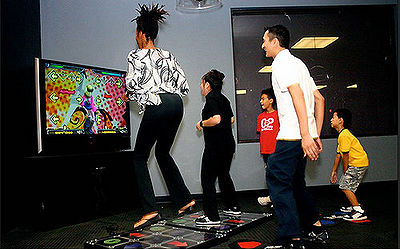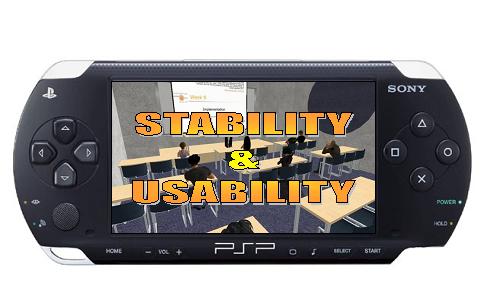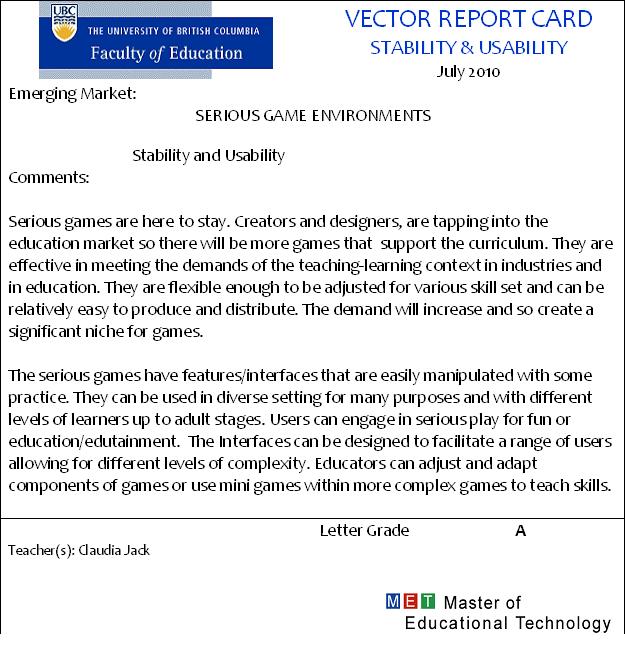Course:ETEC522/2010ST1/SeriousGameEnvironments/Vector3
Introduction
Educators are seeking interesting ways of enhancing teaching and learning interactions. However, there are usability and stability issues that must be considered prior to using serious games in the classroom. The usability issues that must be considered include: the amount of time needed to implement serious games in the classroom, what components are present in an effective serious game, what one needs to set up a serious game and how friendly serious games are to use. How do the features of these games impact their educational value? The biggest stability question is whether serious games are a fad or whether they are here to stay?

Usability
What is Game Usability?
Game usability is defined as the degree to which a player is able to learn, control,and understand a game (Pinelle, D., et al., 2008). Game usability does not address issues of entertainment, engagement and storyline which are tied to both artistic and technical issues. Usability issues include the need to design for visual consistency and readability. Considerations such as user errors while undesirable in some other domains are expected in many games since they are designed to challenge users,and force them to develop new skills so that they can achieve in-game objectives.
Are Serious Games designed for classroom and learner needs?
Serious games are designed for the purpose of solving a problem. Although serious games can be entertaining, their main purpose is to train, investigate, or advertise. Sometimes a games will deliberately sacrifice fun and entertainment in order to make a serious point. Serious games are not a game genre but a category of games with different purposes. This category includes educational games and advergames, political games, or evangelical games (Serious Game, 2007). The category of serious games for training is also known as "game-learning".
Educators are seeking innovative ways to facilitate teaching and learning while maintaining the interest and motivation of our learners. A serious game is usable in the classroom if it offers an authentic learning experiences that are highly transferable and beneficial to the learners.
Some games which are not designed for the classroom may have some disadvantages as learners may be exposed to behaviours that are counterproductive. On the other hand games such as Farmville, SimCity, Second Life , Shark World, Innov8, and Wii Sport immerse the learner in real life problem solving activities which can be transferred to the real world.
With the recent merger of touch sensitive gaming consoles and educational games, serious games are not only portable but they are usable for a broader age group. Games like Brain-Age II has had great success in recent years. Users play various mini-games which masks the educational aspects with its fun interactive activities.
Visit this site and view the video Games and Education to discover some usability components of serious games.
Effective Serious Games
Designers of serious games must pay attention to key aspects of design including game story, pacing, challenge level and game mechanics. Most importantly they must design usable game interfaces so that users experience will be enhanced.
Educational serious games need to be designed with ergonomic and environmental realities of learners and classrooms in mind. Many games are complex, have multi-levels and may take an extended time to be completed. Some may exceed an entire class session. This becomes problematic since although many skills and attitudes may be learnt from all kinds of games, many games are not aligned to the curriculum so teachers may not be able to use them extensively in the regular classroom setting. If they do they run the risk of not completing the prescribed curriculum so considerations may have to be given to out of class engagement. Another reality is that classrooms may not be properly equipped to facilitate the use of games. In some contexts they may even cause disruption to the learning of others.
Mini-games
Are mini-games the solution to the problem of time?
Educators believe that mini-games are the solution to the time factor consideration for other games. Mini-games are useful in that they are easy to learn, hard to master and are usually played in less than an hour (Smith, 2010). There can be several mini-games in one major game. They can be designed for conceptual information and for procedural information. They are fast becoming an effective and relevant method to deliver game based instruction.They should no longer be thought of as just simple quiz style games embedded in a conventional course to break up the monotony of the information. They can be included in a web-based course and they can also be delivered in the context of a larger game or simulation, or combined with other mini-games to build a training experience with greater depth and breadth than was previously possible. Furthermore, mini-games have become sophisticated enough to stand on their own as a legitimate method of training and education with games.
How difficult is it to set up a Serious Games environment?
Serious games are games which require learners to have various technological devices to be engaged in them. Many of the educational games require a computer and an Internet connection. However, other serious games cannot be directly downloaded from the Internet. Therefore, a DVD or CD-ROM disc will be needed to download the serious game on to the computer. The only issues that may arise is a computer that is too old to run the game.
Serious games can also be played on video-game consoles such as the Nintendo Wii and the XBox 360. In order to set up a console based serious game environment on would need the game console, television and game software. Setting up a console based environment would not be difficult as on simply needs to plug audio and video wires into the console and television. Once the television and console are hooked up one simply has to load the software disc into the console and begin playing.
How user-friendly are they?
Serious games are user-friendly. Usually they provide adequate guidelines for users and allows flexibility for new users to manipulate and discover their way. Learners are kept updated on their progress and there is inbuilt motivation or incentives in some games. Trial and error are strong components as there is a strong focus on problem solving. Many allow for multi-users thus allowing for social learning and collaboration. Users will need to know how to play the game by interacting with the interfaces. some games may be more complex and have multiple levels and may take a longer time for some users to master each level. The learning curve for the more complex games is very steep however the simpler games and the mini games the learning curve is not as steep. Generally students who are gamers will quickly master the games.
What do teachers need to know first?
Teachers need to know whether the content and skills facilitated in the game are aligned with the objectives to be met.Games should also be matched with the cognitive level of the learners or must be developmentally appropriate. Additionally the time available for engagement, cost and durability of the game are important factors. If the games are to be purchased the question of the buyer is another consideration.Educators must be aware of the support tools needed and whether the advantages will be greater than the limitations associated with the game. Ease of use is a major consideration. Teachers have to be aware of their own limitations since many teachers are not gamers and may miss the educational benefits in the games. A limitation is that educational games aligned to curricula may be more expensive to produce.
Serious games are considered effective if they score highly in these dimensions:
| Table 1. Key Dimensions of Effective Serious Games | |||||
|---|---|---|---|---|---|
| Dimension | Discussion | ||||
| Provide consistent responses to the user’s actions. | Games should respond to users’ actions in a predictable manner. Basic mechanics, such as hit detection, and character movement, should all be appropriate for the situation that the user is facing. Games should also provide consistent input mappings so that users’ actions always lead to the expected outcome. | ||||
| Allow users to customize video and audio settings, difficulty and game speed. | The video and audio settings, and the difficulty and game speed levels seen in games are not appropriate for all users. The system should allow people to customize a range of settings so that the game accommodates their individual needs. | ||||
| Provide predictable and reasonable behavior for computer controlled units. | In many games, the computer helps the user control the movement of their character, of a small group of teammates, or of a large number of units. Computer controlled units should behave in a predictable fashion, and users should not be forced to issue extra commands to correct faulty artificial intelligence. The game should control units so that pathfinding and other behaviors are reasonable for in-game situations. | ||||
| Provide unobstructed views that are appropriate for the user’s current actions. | Most games provide users with a visual representation (i.e. a “view”) of the virtual location that the user is currently occupying. The game should provide views that allow the user to have a clear, unobstructed view of the area, and of all visual information that is tied to the location. Views should also be designed so that they are appropriate for the activity that the user is carrying out in the game. | ||||
| Allow users to skip non-playable and frequently repeated content. | Many games include lengthy audio and video sequences, or other types of non-interactive content. Games should allow users to skip non-playable content so that it does not interfere with gameplay. | ||||
| Provide intuitive and customizable input mappings. | Most games require rapid responses from the user, so input mapping must be designed so that users can issue commands quickly and accurately. Mappings should be easy to learn and should be intuitive to use, leveraging spatial relationships (the up button is above the down button, etc.) and other natural pairings. They should also adopt input conventions that are common in other similar games (e.g. many first-person shooters and real-time strategy games use similar input schemes). Games should allow users to remap the input settings, should support standard input devices (e.g. mouse, eyboard, gamepad), and should provide shortcuts for expert players. | ||||
| Provide controls that are easy to manage, and that have an appropriate level of sensitivity and responsiveness. | Many games allow users to control avatars such as characters or vehicles. Controls for avatars should be designed so that they are easy for the user to manage, i.e. they are not too sensitive or unresponsive. When controls are based on real world interactions, such as steering a car or using a control stick in an airplane, the game should respond to input in a way that mirrors the real world. Further, games should respond to controls in a timeframe that is suitable for gameplay requirements. | ||||
| Provide users with information on game status. | Users make decisions based on their knowledge of the current status of the game. Examples of common types of information that users need to track include the current status of their character (such as their health, armor status, and location in the game world), objectives, teammates, and enemies. Users should be provided with enough information to allow them to make proper decisions while playing the game. | ||||
| Provide instructions, training, and help. | Many games are complex and have steep learning curves, making it challenging for users to gain mastery of game fundamentals. Users should have access to complete documentation on the game, including how to interpret visual representations and how to interact with game elements. When appropriate, users should be provided with interactive training to coach them through the basics. | ||||
| Provide visual representations that are easy to interpret and that minimize the need for micromanagement. | Visual representations, such as radar views, maps, icons, and avatars, are frequently used to convey information about the current status of the game. Visual representations should be designed so that they are easy to interpret, so that they minimize clutter and occlusion, and so that users can differentiate important elements from irrelevant elements. Further, representations should be designed to minimize the need for micromanagement, where users are forced to interactively search through representation to find needed elements. | ||||
Stability of Serious Games
Are serious games here to stay?
Stability is the state of being stable and the ability to resist change, deterioration or displacement. Serious games are here to stay and will undoubtedly occupy a large part of the education and training of future students and workers in all spheres of life. They will not solve all the problems of life but they are both feasible and desirable in alleviating many of the organizational, structural, educational and administrative problems which often delay action on individual or specific group problems. Their usefulness in illustrating interactions of forces and in analysing them in an emotion- free environment make them suitable for simulated exercises in education and training. They are both instructional and illustrative and valuable to the planner and to the “planned for”.
The growing trend towards increased game use in the classroom is likely to continue into the future as schools seek additional ways to make learning fun, active, relevant and exciting for students and teachers and to lower the barriers which often make school seem uninteresting and irrelevant.
The characteristics of serious games-active, relevant, highly motivating with efficient instructional techniques will expand its use significantly. Serious games may be seen as the answer for the problem of adult education to better equip them for the world of work.
It is expected that games will form a fundamental part of future training and educational programmes because of their ability to aid retention,promote active learning and interaction and provide an authentic environment for facilitating immersion. Learners can try out their skills without any cost in the real world.The stability of serious games is therefore indubitable.
Serious gaming, is poised to take off thanks to the rise of technology populism, the greening of IT, and the emergence of the Millennial Generation. Opportunity comes from many sectors, but competition comes from a hodgepodge of companies, including IBM and Microsoft.
To achieve widespread adoption, the industry must deal with five issues:
1) What games should be called?
2) How slick the presentation should be?
3) How users should interface with the games?
4) How to determine the return on investment of a game?
5) Determining if game technology has any limitations?
Clearing these hurdles will open the door for revolutionary uses of games, but getting from here to there will require patience and guidance on the part of serious games vendors (Keitt, T., et al., 2008). Companies that create simulation games for training like ForgeFX, Playgen, and Serious Games Initiative are just a few of the of the prominent providers of serious games. Certainly there is a sizeable market in serious games which will continue to expand and as more educators realize its benefits curriculum developers will be forced to adjust the way they package subject content to tap into the divergent needs of their learners (Scanlon, J., 2007)
Vector Report Card
Discussion Question
Provide an example of a serious game that you have used in the classroom or for professional or personal development. Comment on usability of the game based on the ten dimensions of effective serious games, as discussed in this vector.
References
Alhadeff, E. (2007, October 11). Serious Games Sizeable Market, Virtual Worlds Sizeable Investment. Message posted to http://elianealhadeff.blogspot.com/2007/10/serious-games-sizeable-market-virtual.html
Keitt, T., Jackson, P., Daley, E., Driver, E., Schooley, C., VanBoskirk, S., Lee, C. (2008). It's Time To Take Games Seriously- Forrester Research. Retrieved July 2,2010 from http://www.forrester.com/rb/Research/time_to_take_games_seriously/q/id/45021/t/2
Generation Y. (n.d.) Retrieved July 9, 2010 from http://en.wikipedia.org/wiki/Generation_Y
Perez, S. (2008, February 27). Technology Populism: Risks & Rewards. Message posted to http://www.readwriteweb.com/archives/technology_populism_risks_rewards.php
Pinelle, D., Wong, N., Stach, T., and Gutwin, C. (2008). Usability Heuristics for Networked Multiplayer Games. Retrieved July 8, 2010 from http://hci.usask.ca/uploads/141-p169-pinelle.pdf
Scanlon, J. (2007, August 13). Getting Serious About Gaming. Message posted to http://www.businessweek.com/innovate/content/aug2007/id20070813_756874.htm
Serious Game. (2007). Retrieved July 9, 2010 from http://en.wikipedia.org/wiki/Serious_game#cite_note-0
Smith, P., and Sanchez, A. (2010). Mini-Games with Major Impacts. Serious Game Design and Development: Technologies for Training and Learning. Retrieved July 2, 2010 from http://www.igi-global.com/bookstore/Chapter.aspx?TitleId=41064

